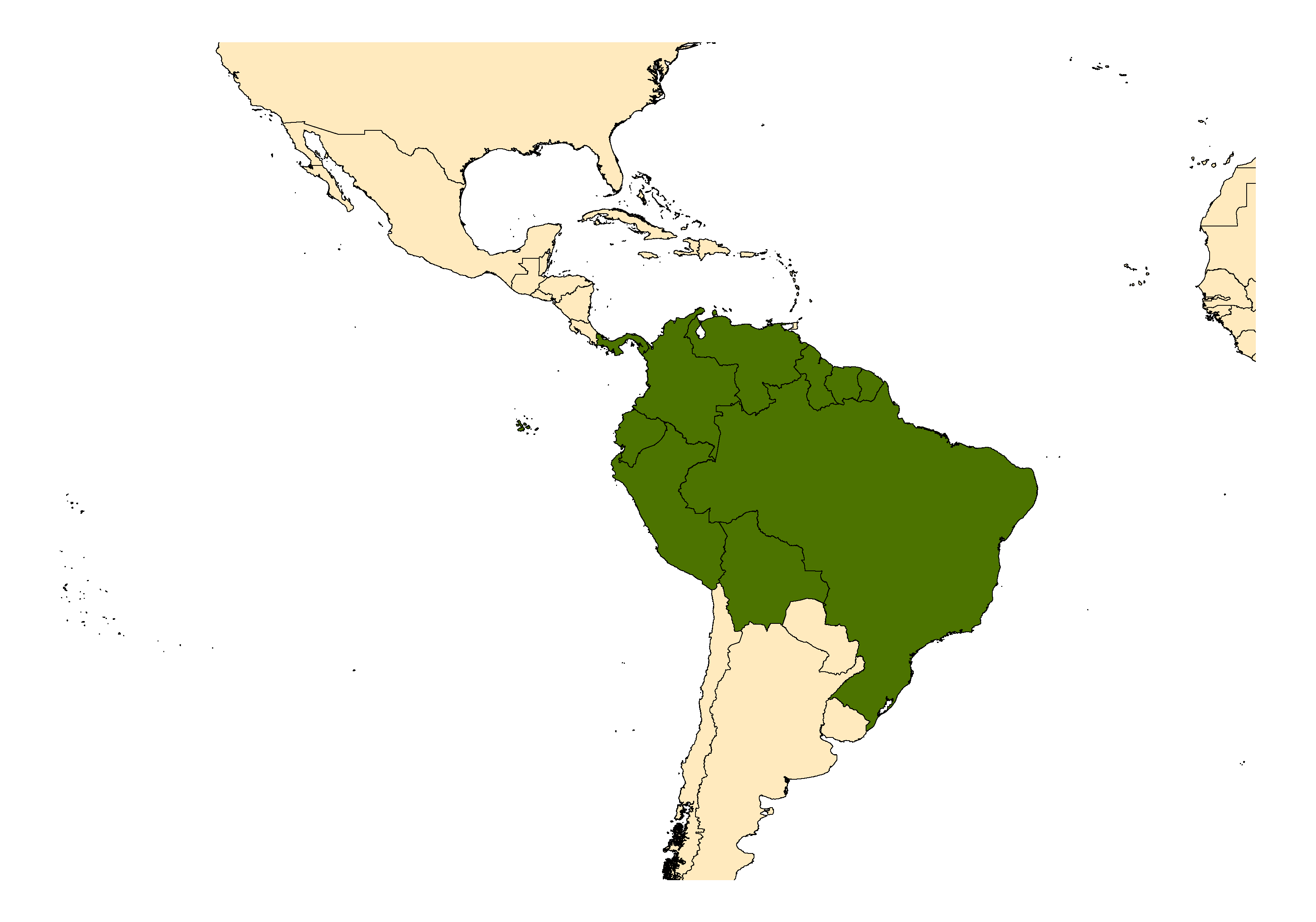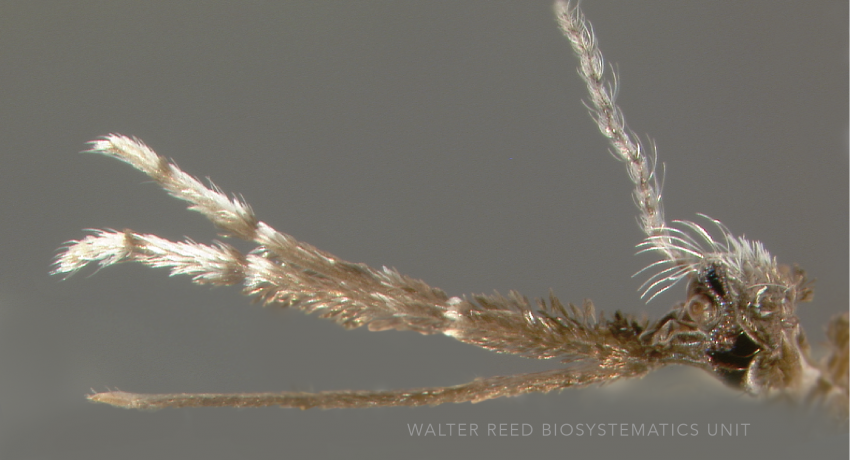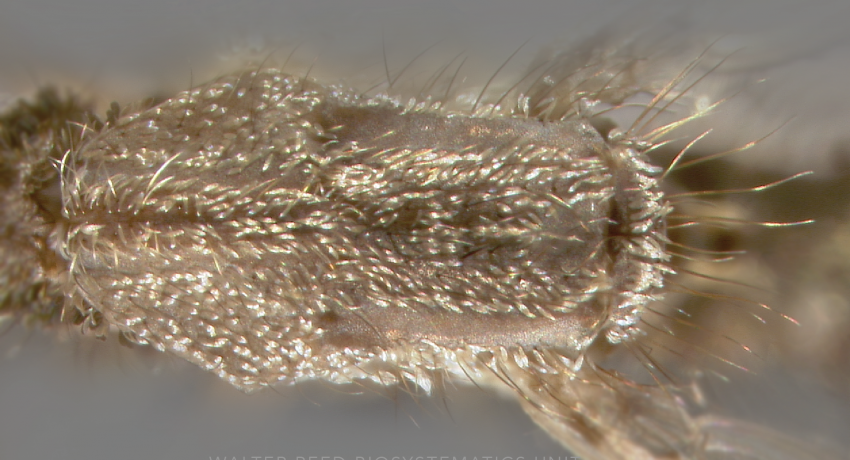NEOTROPICAL REGION
Etymology: Manuel Nuñez-Tovar
Anopheles nuneztovari is recognized by its long white ended palps and hind tarsi, broken only by the narrowest of dark bands. It also sports bushy lateral scale tufts on segments II-VII of the abdomen. Wing morphology characteristics are highly variable even within a single progeny. Anopheles nuneztovari has been exposed as a species complex on the basis of cytogenetics, isozyme analysis and molecular systematics approaches. The Nuneztovari Complex comprises An. dunhami Causey (molecularly confirmed in Brazil, Colombia & Peru), An. goeldii Rozeboom & Gabaldón (molecularly confirmed in Brazil and Suriname), and An. nuneztovari s.s. (molecularly from Bolivia, Colombia and Venezuela) and an additional five independently evolving lineages, dubbed An. nuneztovari lineages 1-5. There are three known cytotypes—nuneztovari A from Brazil, and nuneztovari B/C (which represents one species) from Colombia and Venezuela.
Type locality: San Carlos, Cojedes, Venezuela
Type depository: Museo de Division de Malariologia, Caracas, Venezuela [Now DERM] (MDM)
DIAGNOSTIC CHARACTERS (Click photos to view; mouse over and click large photo to zoom in.)
ADULT (not illustrated): Head: Palpomere MPlp4 with white or cream-colored mediolateral scales, but no yellow scales. Thorax: Prescutellar area with distinct small dark spot, never entirely covering whole area. Wing: Pale wing scales yellowish, at least on anterior veins; accessory sector pale spot about 0.4 from wing base, conspicuously closer to sector pale spot than to subcostal pale spot; sector pale spot on costa <0.5 x length of sector dark spot; vein M stem predominantly pale-scaled. Legs: Fe-III and Ti-III dark with sparse pale scales, not speckled; Ta-III2 with basal dark band ≥0.25 length of segment; Ta-III3 all white; Ta-III5 with basal dark band. Abdomen: At least II–VII-Te covered with scales and with posterolateral dark scale tufts.
LARVA (not illustrated): Head: Setae 2,3-C aciculate, sometimes apically branched; seta 4-C 0.3–0.6 x length of seta 3-C; seta 4-C usually single or double, moderately long, usually extending beyond the base of 2-C; setae 5–7-C plumose. Thorax: Seta 1-P with narrow lanceolate leaflets; setae 1–3-P not inserted on common tubercle. Abdominal segments: Seta 0-II 5–8 branched, subequal or longer than length of leaflets of seta 1-II; seta 1 palmate leaflets smooth-sided; seta 6-IV,V single; seta 11-I very long, 2-4 branched; seta 13-I small, usually >3 branches.
TAXONOMIC KEYS
Faran 1980
Becker et al. 2010
Sallum, et al. 2020
![]()
WRBU - Genera - Global - Larva
![]()
WRBU - Genera - Neotropical - Adult
![]()
WRBU - Genera - Neotropical - Larva
Exemplar DNA sequences
An. nuneztovari ITS2: AY028121, AY028109, AY028128
BIONOMICS
Immatures
The immature habitats of An. nuneztovari s.l. typically include groundwater habitats including lakes, lagoons, rivers, flooded gold mines, fish ponds, ground pools, and, more rarely, tire ruts and animal hoofprints. They have been found in both still and flowing aquatic habitats, but are always associated with fresh, clear water and plentiful floating and/or emergent vegetation.
Adults
Anopheles nuneztovari s.s. (cytotype B/C) is a competent malaria vector in Bolivia, Colombia, and Venezuela. It readily enters homes and feeds on people indoors, biting late into the evening and through the night—peaking between 22:00–02:00. Anopheles nuneztovari A is thought to be primarily zoophilic, and is not incriminated in human malaria transmission. Its peak biting activity is between 18:00 and 20:00. Both An. nuneztovari s.s. and An. nuneztovari A rest outdoors.
DISTRIBUTION NOTES
Bolivia, Brazil, Colombia, Ecuador, French Guiana, Guyana, Panama, Peru, Suriname, Venezuela.

WRBU VECTOR HAZARD REPORTS
None; View other WRBU Vector Hazard Reports
Available GIS Models
IMPORTANT REFERENCES (full citations below)
Gabaldón 1940: 5 (M*)
Rozeboom & Gabaldón 1941: 91 (M*)
Cova García 1946, Fig. 1 (E*), 36 (L*), 88 (F*), 124 (M*)
Floch & Abonnenc 1946c: 3 (M, F, P, L)
Kitzmiller et al. 1973 (chromosomes)
Sutil Oramas 1976: 33 (M*, F*, P*, L*, E*)
Faran 1980: 112 (M*, F*, P*, L*; keys, taxonomy, bionomics, distribution)
Steiner et al. 1980 (chromosomes; s.l.)
Savage 1986 (taxonomy)
Conn 1990 (chromosomes)
Conn et al. 1993 (chromosomes; s.l.)
Hribar 1994 (M genitalia; morphology)
Fritz et al. 1994 (molecular taxonomy; s.l.)
Hribar 1995b (P; morphology)
Hribar 1995a (F; morphology)
Linley et al. 1996 (E*)
Lounibos et al. 1997a (E*)
Lounibos et al. 1998: 830 (genetics, taxonomy)
Sierra et al. 2004 (molecular taxonomy; s.l.)
Calado et al. 2008 (molecular taxonomy; s.l.)
Sinka et al. 2010: 72 (bionomics review, distribution, niche model)
Becker et al. 2010: 380 (F*, L*; key, taxonomy, distribution, bionomics)
Scarpassa & Conn 2011 (molecular taxonomy, phylogenetics; s.l.)
Dusfour et al. 2012 (malaria incrimination)
Conn et al. 2013 (bionomics, distribution; nuneztovari s.l.)
Berti et al. 2015 (distribution; Venezuela)
Sallum, et al. 2020 (keys F, M, L)
CURRENT SYNONYMS
None
CITED REFERENCES
Becker, N., Petrić, D., Zgomba, M., Boase, C., Madon, M., Dahl, C., & Kaiser, A. (2010). Mosquitoes and their control (Second ed.). Berlin Heidelberg: Springer-Verlag.
Berti, J., Guzmán, H., Estrada, Y., & Ramírez, R. (2015). New records of mosquitoes (Diptera: Culicidae) from Bolívar State in South Eastern Venezuela, with 27 new species for the state and 5 of them new in the country. Frontiers in Public Health, 2, 10.
Calado, D.C., Foster, P.G., Bergo, E.S., dos Santos, C.L.S., Galardo, A.K.R., & Sallum, M.A.M. (2008). Resurrection of Anopheles goeldii from synonymy with Anopheles nuneztovari (Diptera, Culicidae) and a new record for Anopheles dunhami in the Brazilian Amazon. Memórias do Instituto Oswaldo Cruz, 103(8), 791–799.
Conn, J. (1990). A genetic study of the malaria vector Anopheles nuneztovari from western Venezuela. Journal of the American Mosquito Control Association, 6(3), 400–406.
Conn, J., Quiñones, M., & Póvoa, M.M. (2013). Phylogeography, vectors, and transmission in Latin America. In S. Manguin (Ed.), Anopheles mosquitoes-new insights into malaria vectors (pp. 145–172). Janeza Trdine 9, 51000 Rijeka, Croatia: InTech.
Conn, J., Rangel Puertas, Y., & Seawright, J.A. (1993). A new cytotype of Anopheles nuneztovari from western Venezuela and Colombia. Journal of the American Mosquito Control Association, 9(3), 294–301.
Cova García, P. (1946). Notas sôbre los anofelinos de Venezuela y su identificacion. (CSP12/C1). Editorial Grafolit.
Dusfour, I., Issaly, J., Carinci, R., Gaborit, P., & Girod, R. (2012). Incrimination of Anopheles (Anopheles) intermedius Peryassu, An. (Nyssorhynchus) nuneztovari Gabaldon, An. (Nys.) oswaldoi Peryassu as natural vectors of Plasmodium falciparum in French Guiana. Memórias do Instituto Oswaldo Cruz, 107(3), 429-NIL_0188.
Faran, M.E. (1980). Mosquito studies (Diptera: Culicidae) XXXIV. A revision of the Albimanus section of the subgenus Nyssorhynchus of Anopheles. Contributions of the American Entomological Institute, 15(7), 1–215.
Floch, H., & Abonnenc, E. (1946c). Sur A. nunez-tovari et A. pessoai en Guyane Franҫaise. Table d'identification des Nyssorhynchus guyanais. Archives de l'Institut Pasteur de la Guyane française et du Territoire de l'Inini, 126, 1–5.
Fritz, G.N., Conn, J., Cockburn, A., & Seawright, J. (1994). Sequence analysis of the ribosomal RNA internal transcribed spacer 2 from populations of Anopheles nuneztovari (Diptera: Culicidae). Molecular Biology and Evolution, 11(3), 406–416.
Gabaldon, A. (1940). Estudios sôbre anofelinos. Serie I. 1. Descripción de Anopheles (Nyssorhynchus) nuneztovari n. sp., y consideraciones sôbre una sub-division del grupo Nyssorhynchus (Diptera, Culicidae). Públicaciones de la Division de Malariologia, 5, 3–7.
Hay, S.I., Sinka, M.E., Okara, R.M., Kabaria, C.W., Mbithi, P.M., Tago, C.C., …Godfray, H.C.J. (2010). Developing global maps of the dominant Anopheles vectors of human malaria. PLoS Medicine, 7(2): e1000209.
Hribar, L.J. (1994). Geographic variation of male genitalia of Anopheles nuneztovari (Diptera: Culicidae). Mosquito Systematics, 26(3), 132–144.
Hribar, L.J. (1995a). Costal wing spot variation within and among progeny of single female Anopheles nuneztovari (Diptera: Culicidae). Mosquito Systematics, 27(1), 1–15.
Hribar, L.J. (1995b). Larval and pupal chaetotaxy of Anopheles nuneztovari (Diptera: Culicidae). Transactions of the American Entomological Society, 121(4), 249–225.
Kitzmiller, J.B., Kreutzer, R.D., & Tallaferro, E. (1973). Chromosomal differences in populations of Anopheles nuneztovari. Bulletin of WHO, 48, 435–455.
Linley, J.R., Lounibos, L.P., Conn, J., Duzak, D., & Nishimura, N. (1996). A description and morphometric comparison of eggs from eight geographic populations of the South American malaria vector Anopheles (Nyssorhynchus) nuneztovari (Diptera: Culicidae). Journal of the American Mosquito Control Association, 12(2), 275–292.
Lounibos, L.P., Duzak, D., & Linley, J.R. (1997a). Comparative egg morphology of six species of the Albimanus Section of Anopheles (Nyssorhynchus) (Diptera: Culicidae). Journal of Medical Entomology, 34(2), 136–155.
Lounibos, L.P., Wilkerson, R.C., Conn, J.E., Hribar, L.J., Fritz, G.N., & Danoff-Burg, J.A. (1998). Morphological, molecular, and chromosomal discrimination of cryptic Anopheles (Nyssorhynchus) (Diptera: Culicidae) from South America. Journal of Medical Entomology, 35(5), 830–838.
Ponce, P., Cevallos, V., & Carrazco-Montalvo, A. (2021). Mosquitoes (Diptera: Culicidae) of Ecuador: A revised checklist, new records and species of medical importance. bioRxiv.
Rozeboom, L.E., & Gabaldon, A. (1941). A summary of the “tarsimaculatus” complex of Anopheles (Diptera: Culicidae). American Journal of Hygiene, 3, 88–100.
Sallum, M.A.M., Obando, R.G., Carrejo, N. et al. Identification key to the Anopheles mosquitoes of South America (Diptera: Culicidae). Parasites and Vectors, 13, 542 (2020). https://www.biomedcentral.com/collections/id-keys-anopheles
Savage, H.M. (1986). Identification and location of the holotype and paratypes of Anopheles (Nyssorhynchus) nuneztovari Gabaldon (Diptera: Culicidae). Mosquito Systematics, 18(3,4), 279–284.
Scarpassa, V.M., & Conn, J.E. (2011). Mitochondrial DNA detects a complex evolutionary history with Pleistocene Epoch divergence for the neotropical malaria vector Anopheles nuneztovari Sensu Lato. American Journal of Tropical Medicine and Hygiene, 85(5), 857–867.
Sierra, D.M., Velez, I.D., & Linton, Y.-M. (2004). Malaria vector Anopheles (Nyssorhynchus) nuneztovari comprises one genetic species in Colombia based on homogeneity of nuclear ITS2 rDNA. Journal of Medical Entomology, 41(3), 302–307.
Steiner, W.W.M., Kitzmiller, J.B., & Osterbur, D.L. (1980). Gene differentiation in chromosome races of Anopheles nuneztovari (Gabaldon). Mosquito Systematics, 12(3), 306–319.
Sutil Oramas, E. (1976). Redescripción de la espécie Anopheles (Nyssorhynchus) nunez-tovari Gabaldon, 1940, y su distribución geográfica en Venezuela. Boletín de la Dirección de Malariología y Saneamiento Ambiental, 16(1), 33–45.
CITE THIS PAGE
Walter Reed Biosystematics Unit (Year). Anopheles nuneztovari species page. Walter Reed Biosystematics Unit Website, http://wrbu.si.edu/vectorspecies/mosquitoes/nuneztovari, accessed on [date (e.g. 03 February 2020) when you last viewed the site].











































































































































































